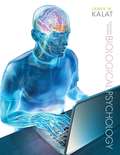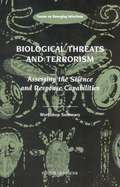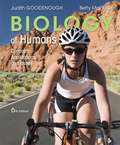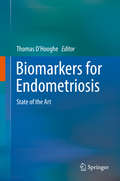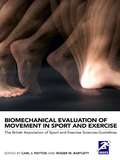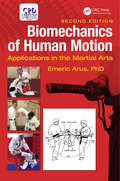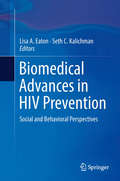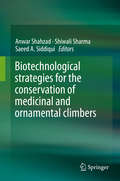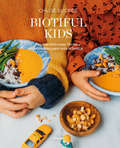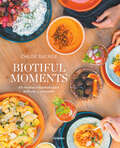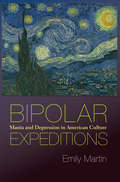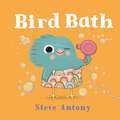- Table View
- List View
Biological Cognition (Elements in Philosophy of Mind)
by Jay Schulkin Bryce HuebnerThis Element introduces a biological approach to cognition, which highlights the significance of allostatic regulation and the navigation of challenges and opportunities. It argues that cognition is best understood as a juggling act, which reflects numerous ongoing attempts to minimize disruptions while prioritizing the sources of information that are necessary to satisfy social and biological needs; and it provides a characterization of the architectural constraints, neurotransmitters, and affective states that shape visual perception, as well as the regulatory capacities that sustain flexible patterns of thought and behavior.
Biological Naturalism and the Mind-Body Problem
by Jane AndersonThis book offers a new theoretical framework within which to understand “the mind-body problem”. The crux of this problem is phenomenal experience, which Thomas Nagel famously described as “what it is like” to be a certain living creature. David Chalmers refers to the problem of “what-it-is-like” as “the hard problem” of consciousness and claims that this problem is so “hard” that investigators have either just ignored the issue completely, investigated a similar (but distinct) problem, or claimed that there is literally nothing to investigate – that phenomenal experience is illusory. This book contends that phenomenal experience is both very real and very important. Two specific “biological naturalist” views are considered in depth. One of these two views, in particular, seems to be free from problems; adopting something along the lines of this view might finally allow us to make sense of the mind-body problem.An essential read for anyone who believes that no satisfactory solution to “the mind-body problem” has yet been discovered.
Biological Psychology (Eleventh Edition)
by James W. KalatThe most widely used text in its course area, Dr. James W. Kalat's BIOLOGICAL PSYCHOLOGY appeals to students and instructors alike. Throughout all eleven editions, the goal has been to make biological psychology accessible to psychology students, not just to biology majors and pre-meds. The goal has also been to convey the excitement of the search for biological explanations of behavior. Kalat believes that biological psychology is "the most interesting topic in the world," and this text convinces many students--and perhaps you, too--with its clear writing style, amusing anecdotes, and intriguing examples. A media-rich, highly interactive online eBook integrates the text with videos, animations, and an online bio-lab component, making it easier for you to learn.
Biological Threats and Terrorism: Workshop Summary
by Leslie A. Pray Stacey L. Knobler Adel A. F. MahmoudIn the wake of September 11th and recent anthrax events, our nation's bioterrorism response capability has become an imminent priority for policymakers, researchers, public health officials, academia, and the private sector. In a three-day workshop, convened by the Institute of Medicine's Forum on Emerging Infections, experts from each of these communities came together to identify, clarify, and prioritize the next steps that need to be taken in order to prepare and strengthen bioterrorism response capabilities. From the discussions, it became clear that of utmost urgency is the need to cast the issue of a response in an appropriate framework in order to attract the attention of Congress and the public in order to garner sufficient and sustainable support for such initiatives. No matter how the issue is cast, numerous workshop participants agreed that there are many gaps in the public health infrastructure and countermeasure capabilities that must be prioritized and addressed in order to assure a rapid and effective response to another bioterrorist attack.
Biological Timekeeping: Clocks, Rhythms and Behaviour
by Vinod KumarThis book is a concise, comprehensive and up-to-date account of fundamental concepts and potential applications of biological timekeeping mechanisms in animals and humans. It also discusses significant aspects of the organization and importance of timekeeping mechanisms in both groups. Divided into seven sections, it addresses important aspects including fundamental concepts; animal and human clocks; clock interactions; clocks and metabolism and immune functions; pineal, melatonin and timekeeping; and clocks, photoperiodism and seasonal behaviours. The book also focuses on biological clock applications in a 24x7 human society, particularly in connection with life-style associated disorders like obesity and diabetes. It is a valuable resource for advanced undergraduates, researchers and professionals engaged in the study of the science of biological timekeeping.
Biology of Humans: Concepts, Applications, and Issues (6th Edition)
by Judith Goodenough Betty A. McGuireFor courses in non-majors biology. Helps students learn the concepts and applications of human biology using relevant topics and realistic scenarios Known for its unique "Special Topic" chapters and emphasis on everyday health concerns, the 6th Edition of Biology of Humans: Concepts, Applications, and Issues continues to personalize the study of human biology using a conversational writing style, vibrant, easy-to-follow illustrations, abundant applications, and a new emphasis on using everyday science literacy skills. The authors provide a practical, friendly introduction to the study of the human body, preparing readers to navigate today's rapidly expanding and shifting world of health information. Each chapter now features brand-new "Consider This Case" exercises and "Finding and Evaluating Information" activities that challenge readers to think critically and apply their knowledge to solve real-world cases. Along with scientific updates and content improvements throughout the text, the 6th Edition also includes a new "Special Topic" chapter on the Obesity Epidemic.
Biology of Humans: Concepts, Applications and Issues, 5th Edition
by Betty Mcguire Judith GoodenoughEach chapter now opens with new “Did You Know?” questions that pique your interest with intriguing and little-known facts about the topic that follows. The Fifth Edition also features a new “Special Topic” chapter (1a) titled “Becoming a Patient: A Major Decision,” which discusses how to select a doctor and/or a hospital, how to research health conditions, and more.
Biomarkers for Endometriosis
by Thomas D'HoogheThis book presents an overview of the diagnostic performance of non- or semi-invasive tests for endometriosis in peripheral blood, endometrium, saliva, peritoneal fluid and urine. The value of existing and emerging systems biology technologies for biomarker development is addressed in several chapters on genetics, microarrays, proteomics and metabolomics. Although tests with high sensitivity and acceptable specificity have been developed, sometimes validated in independent populations and seem promising, more research is needed to translate these data into clinical benefit for patients and coordinate efforts internationally to standarize analysis, reports and operating procedures. The gold standard to diagnose endometriosis is currently through laparoscopic inspection with histological confirmation, a surgical procedure with rare but significant potential risks for the patients. A non-invasive test for endometriosis would be critical for the early detection of endometriosis of symptomatic women with pelvic pain and/or subfertility with normal ultrasound. This would include nearly all cases of minimal-mild endometriosis, some cases of moderate-severe endometriosis without a clearly visible ovarian endometrioma and cases with pelvic adhesions and/or other pelvic pathology, who might benefit from surgery to improve pelvic pain and/or subfertility. Such a test would also be useful in symptomatic women with ultrasound imaging suspicious for endometriosis, since it may be difficult to differentiate an ovarian endometrioma from other ovarian cysts and since the quality of ultrasound imaging is highly variable worldwide.
Biomechanical Evaluation of Movement in Sport and Exercise: The British Association of Sport and Exercise Sciences Guide
by Carl Payton Roger BartlettPublished in association with the British Association of Sport and Exercise Sciences, this is the only up-to-date, practical guide to using the range of biomechanics movement analysis machines, equipment and software available today. It includes detailed explanations of the key theory underlying biomechanics testing, along with advice concerning choice of equipment and how to use your laboratory equipment most effectively. The book covers the following important topics in detail: motion analysis using video and on-line systems measurement of force and pressure in the laboratory and field measurement of power using isokinetic dynamometry electromyography computational simulation and modelling of human movement research methodologies, data processing and data smoothing. Contributors include world leading researchers and pioneers such as Roger Bartlett, Carl Payton, Vasilios (Bill) Baltzopoulos, Adrian Burden, John H. Challis, and computer modelling maestro Fred Yeadon. Biomechanical Evaluation of Movement in Sport and Exercise is a must-have text for all biomechanics laboratories and students undertaking research.
Biomechanics of Human Motion: Applications in the Martial Arts, Second Edition
by Emeric Arus, Ph.D.This book covers the general laws governing human biomechanics through an extensive review of martial arts techniques and references to fundamental theory. Using straightforward mathematics and physics, this work covers indepth the anatomical foundation of biomechanics and physiological foundation of human motion through specific and relevant martial arts applications. This book also covers the kinematics and kinetics of biomechanics via examples from martial arts and their comparison to different sports techniques. It is written to be used and referenced by biomechanical professionals and martial arts enthusiasts.
Biomedical Advances in HIV Prevention: Social and Behavioral Perspectives
by Seth C. Kalichman Lisa A. EatonBiomedical Advances in HIV Prevention: Social and Behavioral Perspectives Lisa A. Eaton and Seth C. Kalichman, editors Three decades into the epidemic, a great deal is known about HIV and its transmission, more people are living with the disease, and the virus is no longer seen as a death sentence. But new people continue to be infected with HIV each year, making prevention strategies that are medically effective and behaviorally engaging as urgent a priority as ever. Biomedical Advances in HIV Prevention: Social and Behavioral Perspectives assembles the latest improvements, barriers to implementation, and possibilities for--and challenges to--future progress. Innovations such as pre-exposure prophylaxis (antiretroviral regimens for the high-risk uninfected) and treatment as prevention (early use of ART to reduce infectiousness of new patients) are examined, as are current findings on ongoing prevention and treatment concerns. Contributors illuminate the complex realities entailing adherence, pointing out technological, behavioral, and cultural roadblocks as well as opportunities to significantly reduce infection rates. Detailed up-to-the-minute coverage includes: Prevention services for persons living with HIV Adherence to HIV treatment as prevention and pre-exposure prophylaxis Advocating for rectal microbicides and safe lubricants Mental health and substance use in the scale-up of HIV prevention Risk compensation in response to HIV prevention Implementing biomedical HIV prevention advances: reports from South Africa, Uganda, Australia, Thailand, United States, Ecuador, and Peru Researchers, practitioners, and policy makers working in the fields of HIV/AIDS and public health will look toward Biomedical Advances in HIV Prevention: Social and Behavioral Perspectives as both a means for developing and assessing current programs and a blueprint for the next generation of prevention efforts.
Biomedical Photonics for Diabetes Research (Series in Medical Physics and Biomedical Engineering)
by Valery Tuchin Andrey V. DunaevIn 2021, over 537 million people worldwide were diagnosed with diabetes, according to the International Diabetes Federation and so the diagnosis, care and treatment of patients with diabetes mellitus have become one of the highest healthcare priorities. Biomedical photonics methods have been found to significantly improve and assist in the diagnosis of various disorders and complications arising from diabetes. These methods have also been widely used in various studies in the field of diabetes, including in the assessment of biochemical characteristics, metabolic processes, and microcirculation that are impaired in this disease. This book provides an introduction to methods of biomedical photonics. The chapters, written by world-leading experts, cover a wide range of issues, including the theoretical basis of different biophotonics methods and practical issues concerning the conduction of experimental studies to diagnose disorders associated with diabetes. It provides a comprehensive summary of the recent advances in biomedical optics and photonics in the study of diabetes and related complications. This book will be of interest to biomedical physicists and researchers, in addition to practicing doctors and endocrinologists looking to explore new instrumental methods for monitoring the effectiveness of patient treatment. Features • The first collective book combining accumulated knowledge and experience in the field of diabetes research using biophotonics. • Contributions from leading experts in the field. • Combines the theoretical base of the described methods and approaches, as well as providing valuable practical guidance and the latest research from experimental studies.
Biomedicalization and the Practice of Culture: Globalization and Type 2 Diabetes in the United States and Japan (Studies in Social Medicine)
by Mari Armstrong-HoughOver the last twenty years, type 2 diabetes skyrocketed to the forefront of global public health concern. In this book, Mari Armstrong-Hough examines the rise in and response to the disease in two societies: the United States and Japan. Both societies have faced rising rates of diabetes, but their social and biomedical responses to its ascendance have diverged. To explain the emergence of these distinctive strategies, Armstrong-Hough argues that physicians act not only on increasingly globalized professional standards but also on local knowledge, explanatory models, and cultural toolkits. As a result, strategies for clinical management diverge sharply from one country to another. Armstrong-Hough demonstrates how distinctive practices endure in the midst of intensifying biomedicalization, both on the part of patients and on the part of physicians, and how these differences grow from broader cultural narratives about diabetes in each setting.
Bioprospecting: Success, Potential and Constraints (Topics in Biodiversity and Conservation #16)
by Russell Paterson Nelson LimaThis book considers all aspects of bioprospecting in 14 succinct chapters and a forward by David Hawksworth. The organisms addressed include plants, insects, fungi, bacteria and phages. Bioprospecting has never been more relevant and is of renewed interest, because of the extremely worrying rise in novel, resistant pathogenic microorganisms. The practices in pharmaceutical companies have failed to deliver novel antibiotics to control these infections. We need to look for new sources of drugs from the environment on a massive scale as drug discovery is "too important to fail". Furthermore, the field can add great value to ecosystems in terms of economics, while providing additional reasons for maintaining associated services, such as food provision, benign climate, effective nutrient cycling and cultural practices. Bioprospecting provides another reason why climate change must be reduced in order to preserve relevant environments. Previous bioprospecting projects should be re-visited and established biodiversity centres have a major role. Many different ecosystems exist which contain unique organisms with the potential to supply novel antibiotics, enzymes, food, and cosmetics, or they may simply have aesthetic value. The book stresses the difficulties in obtaining successful products and yet describes why natural products should be investigated over combinatorial chemistry. Personal experience of bioprospecting projects are given significance. Issues such as how to share the benefits equitably with local communities are described and why pharmaceutical companies can be reluctant to be involved. Legal issues are discussed. Finally, there has never been a better time for a new book on bioprospecting, because of the need to preserve ecosystems, and from the emergence of resistant pathogenic microorganisms.
Biosocialities, Genetics and the Social Sciences: Making Biologies and Identities
by Sahra Gibbon Carlos NovasBiosocialities, Genetics and the Social Sciences explores the social, cultural and economic transformations that result from innovations in genomic knowledge and technology. This pioneering collection uses Paul Rabinow’s concept of biosociality to chart the shifts in social relations and ideas about nature, biology and identity brought about by developments in biomedicine. Based on new empirical research, it contains chapters on genomic research into embryonic stem cell therapy, breast cancer, autism, Parkinson’s and IVF treatment, as well as on the expectations and education surrounding genomic research. It covers four main themes: novel modes of identity and identification, such as genetic citizenship the role of institutions, ranging from disease advocacy organizations and voluntary organizations to the state the production of biological knowledge, novel life-forms, and technologies the generation of wealth and commercial interests in biology. Including an afterword by Paul Rabinow and case studies on the UK, US, Canada, Germany, India and Israel, this book is key reading for students and researchers of the new genetics and the social sciences – particularly medical sociologists, medical anthropologists and those involved with science and technology studies.
Biotechnological strategies for the conservation of medicinal and ornamental climbers
by Anwar Shahzad Shiwali Sharma Saeed A. SiddiquiThe book provides an overview on adoption of biotechnological approaches for the conservation, micropropagation, synseed production of various medicinal and ornamental climbers. The work includes a brief chapter on evolution and diversification of climbers. Other chapters give insights on protocols for in vitro propagation and synseed production of selected threatened medicinal and ornamental climbers. Informative chapter on the production of bioactive compound and their enhancement through genetic transformation and elicitation have been incorporated to cover latest advancement in the field of plant biotechnology. This book also explores the use of molecular marker technique for the desired improvement/magnification of medicinal and aesthetic value of climbing plants.
Biotechnology and the Human Good
by Jean Bethke Elshtain Scott B. Rae C. Ben Mitchell Edmund D. Pellegrino John F. KilnerSome of humankind's greatest tools have been forged in the research laboratory. Who could argue that medical advances like antibiotics, blood transfusions, and pacemakers have not improved the quality of people's lives? But with each new technological breakthrough there comes an array of consequences, at once predicted and unpredictable, beneficial and hazardous. Outcry over recent developments in the reproductive and genetic sciences has revealed deep fissures in society's perception of biotechnical progress. Many are concerned that reckless technological development, driven by consumerist impulses and greedy entrepreneurialism, has the potential to radically shift the human condition -- and not for the greater good. Biotechnology and the Human Good builds a case for a stewardship deeply rooted in Judeo-Christian theism to responsibly interpret and assess new technologies in a way that answers this concern. The authors jointly recognize humans not as autonomous beings but as ones accountable to each other, to the world they live in, and to God. They argue that to question and critique how fields like cybernetics, nanotechnology, and genetics might affect our future is not anti-science, anti-industry, or anti-progress, but rather a way to promote human flourishing, common sense, and good stewardship. A synthetic work drawing on the thought of a physician, ethicists, and a theologian, Biotechnology and the Human Good reminds us that although technology is a powerful and often awe-inspiring tool, it is what lies in the heart and soul of who wields this tool that truly makes the difference in our world.
Biotiful Kids: Recetas deliciosas, sencillas y saludables para toda la familia
by Chloé SucréeIdeas, trucos e inspiración para preparar comidas diarias ¡y que los niños disfruten y repitan! Alimentar bien a nuestros hijos, a veces, no es tarea fácil. Los niños cambian de gustos a menudo: un día les encanta el brócoli y al día siguiente es lo peor que han probado en su vida. Puede llegar a ser agotador. Pero también es muy gratificante ver como comen todo lo que hemos preparado, con ganas y disfrutándolo. Con estas 90 nuevas recetas, Chloé quiere ayudarnos a que los más pe-queños se alimenten de la mejor forma: equilibrada, con sentido común, que se sientan llenos de energía y, sobre todo, sin obsesiones ni agobios por nuestra parte. «Tengo dos hijos con opiniones sobre todo lo que viven y comen, y que pueden llegar a ser muy exigentes. Eso no quiere decir que tenga que sucumbir a todos sus deseos, pero he aprendido a ser más flexible y creativa.» Chloé Sucrée
Biotiful Moments: 90 recetas saludables para disfrutar y compartir
by Chloé SucréeLa intención de Chloé sigue siendo la misma:Ofrecerte 90 recetas para que te cuides y comas bien. Esta vez, además, quiere ayudarte a convertir cualquier momento alrededor de la mesa en algo extraordinario y singular. Para ello ha elegido 10 biotiful moments: 1. Brunchs, vermuts y BBQ con amigos2. Feeling good3. Cena para dos4. Fiestas en familia5. De picnic6. Menú solo7. Viajes en ruta8. Merienda con niños9. Post baby10.Team teenager Porque no es lo mismo preparar una cena romántica, que hacerte un caldo nutritivo cuando necesitas mimos o que llevar algo cómodo y resultón para una barbacoa con amigos. «Yo, siempre que puedo, busco mis biotiful moments. No tienen que ser días especiales de por sí. Más bien procuro hacer de lo ordinario algo extraordinario. Todo es cuestión de perspectiva, buena actitud y de ponerle ganas. Te invito a hacer lo mismo. Te sorprenderá la cantidad de momentos mágicos que pueden aparecer.»
Bipolar Expeditions: Mania and Depression in American Culture
by Emily MartinManic behavior holds an undeniable fascination in American culture today. It fuels the plots of best-selling novels and the imagery of MTV videos, is acknowledged as the driving force for successful entrepreneurs like Ted Turner, and is celebrated as the source of the creativity of artists like Vincent Van Gogh and movie stars like Robin Williams. Bipolar Expeditions seeks to understand mania's appeal and how it weighs on the lives of Americans diagnosed with manic depression. Anthropologist Emily Martin guides us into the fascinating and sometimes disturbing worlds of mental-health support groups, mood charts, psychiatric rounds, the pharmaceutical industry, and psychotropic drugs. Charting how these worlds intersect with the wider popular culture, she reveals how people living under the description of bipolar disorder are often denied the status of being fully human, even while contemporary America exhibits a powerful affinity for manic behavior. Mania, Martin shows, has come to be regarded as a distant frontier that invites exploration because it seems to offer fame and profits to pioneers, while depression is imagined as something that should be eliminated altogether with the help of drugs. Bipolar Expeditions argues that mania and depression have a cultural life outside the confines of diagnosis, that the experiences of people living with bipolar disorder belong fully to the human condition, and that even the most so-called rational everyday practices are intertwined with irrational ones. Martin's own experience with bipolar disorder informs her analysis and lends a personal perspective to this complex story.
Bipolar and Pregnant: How to Manage and Succeed in Planning and Parenting While Living with Manic Depression
by Kristen K. FinnThe first book to tackle one of the leading concerns of women with manic depression and related disorders<P> You have bipolar disorder and want to start a family. There is so much to know and manage when thinking about becoming pregnant and having an optimal pregnancy and postpartum period. What are the risks? Can I go off my meds? How will my partner react? Will my child also become bipolar? How do I navigate through the often confusing and ever-changing research on mental disorders and pregnancy?<P> Kristin K. Finn was diagnosed with manic depression as a teenager. Upon deciding to become pregnant, she and her husband also had questions, concerns, and fears. Recognizing that there was no go-to guide that helps women with manic depression navigate pre-natal, pregnancy, and postpartum issues, Finn collaborated with geneticists, obstetricians, psychologists, and psychiatrists to bring you this ultimate support-group-in-a-book and pregnancy resource.<P> In Bipolar and Pregnant, Finn shares her insights and techniques that she developed through two pregnancies, as well as the advice of her esteemed team of experts. In addition, Bipolar and Pregnant:<P> * Provides information on medical aspects of pregnancy and gives advice on minimizing the risks of psychiatric flare-ups, avoiding episodes, monitoring behavior, and preparing to go off mediation as pregnancy looms.<P> * Discusses medical aspects of pregnancy, preparing for pregnancy, and optimizing the chances of getting pregnant<P> * Provides the latest research on medications used to treat bipolar disorder and their effect on developing babies.<P> You and your entire support team will be armed with the knowledge necessary to help you optimize your pregnancy, subside anxiety, and feel confident that you are doing the very best for you and your new family.
Bipolarismo II - Oltre l'infelice diagnosi e verso una vita felice
by Evelyn TomsonUna storia personale sul modo in cui l'autrice ha scoperto la sua malattia, come ha attraversato gli alti e bassi in modo positivo e ottimista fino a trovare il suo equilibrio e la sua felicità.
Bird
by Kristin Rosetta Elliott HoodJohn Steptoe Award for New Talent in Illustrations Winner - American Library Association (ALA)In this gentle, award-winning picture book, an African American boy nicknamed Bird uses drawing as a creative outlet as he struggles to make sense of his grandfather's death and his brother's drug addiction.Young Mekhai, better known as Bird, loves to draw. With drawings, he can erase the things that don't turn out right. In real life, problems aren't so easily fixed. As Bird struggles to understand the death of his beloved grandfather and his older brother's drug addiction, he escapes into his art. Drawing is an outlet for Bird's emotions and imagination, and provides a path to making sense of his world. In time, with the help of his grandfather's friend, Bird finds his own special somethin' and wings to fly. Told with spare grace, Bird is a touching look at a young boy coping with real-life troubles. Readers will be heartened by Bird's quiet resilience, and moved by the healing power of putting pencil to paper. Bird, the recipient of Lee & Low's New Voices Award Honor, is the first picture book of both Zetta Elliot and Shadra Strickland.
Bird Bath
by Steve AntonyMeet a bird, in need of a bath! From the award-winning creator of the Mr. Panda series, with over 1 million copies sold worldwide, comes the second book in Steve Antony's new and exciting picture book series for young children—and their grownups.These four mucky birds are in need of a bath! They’ve got soap, shampoo and a big bottle of bubble bath, but can they be trusted not to use it all? And will they keep the water inside the tub? Well, at least they’ll be squeaky clean! The real trouble is, when bath time is this much fun, absolutely EVERYONE wants to get in! Clever and utterly relatable, with a playful, pitch-perfect text, these books take a fresh look at key childhood moments, emotions, and milestones—like learning to take a bath—with humor and simplicity.
Bird Magic: Wisdom of the Ancient Goddess for Pagans & Wiccans
by Sandra KynesConnect to the Great Goddess through the Magic of BirdsBirds have been symbolic of the Great Goddess for millennia, representing her power and connection to the mysteries of life, death, and spirit. Bird Magic teaches you how to commune with the Goddess, incorporating her into your magical life through exercises, crafts, meditations, and more.Working with bird magic helps awaken your intuition, tap into subtle energies around you, and strengthen your bond with the natural world. Providing an encyclopedic listing of more than sixty bird species—highlighting each one's history, folklore, location, appearance, and magical wisdom—Bird Magic shows how they can enhance your spiritual and personal life. With in-depth information, helpful illustrations, and hands-on guidance, this book will be your go-to reference for years to come.


